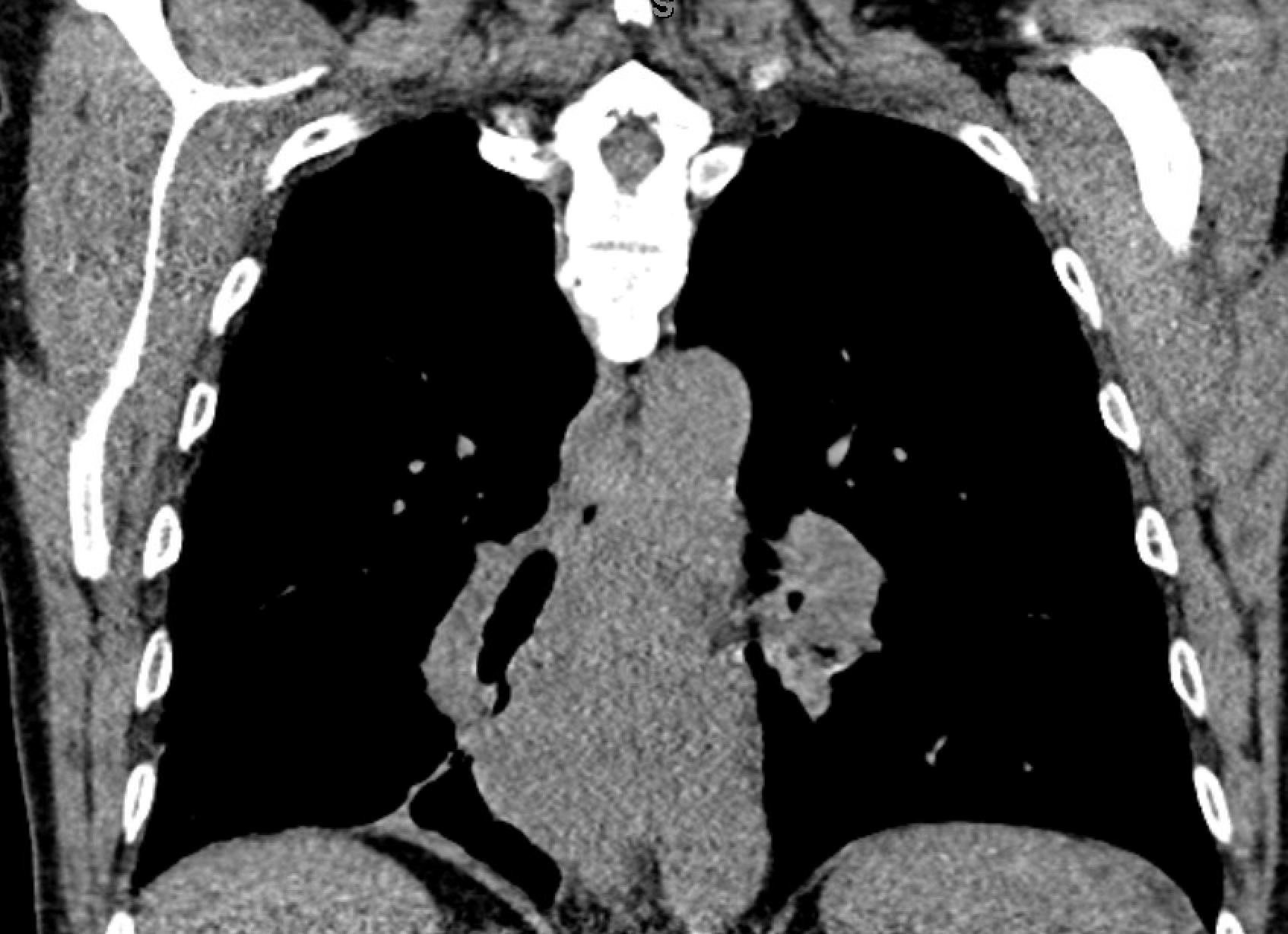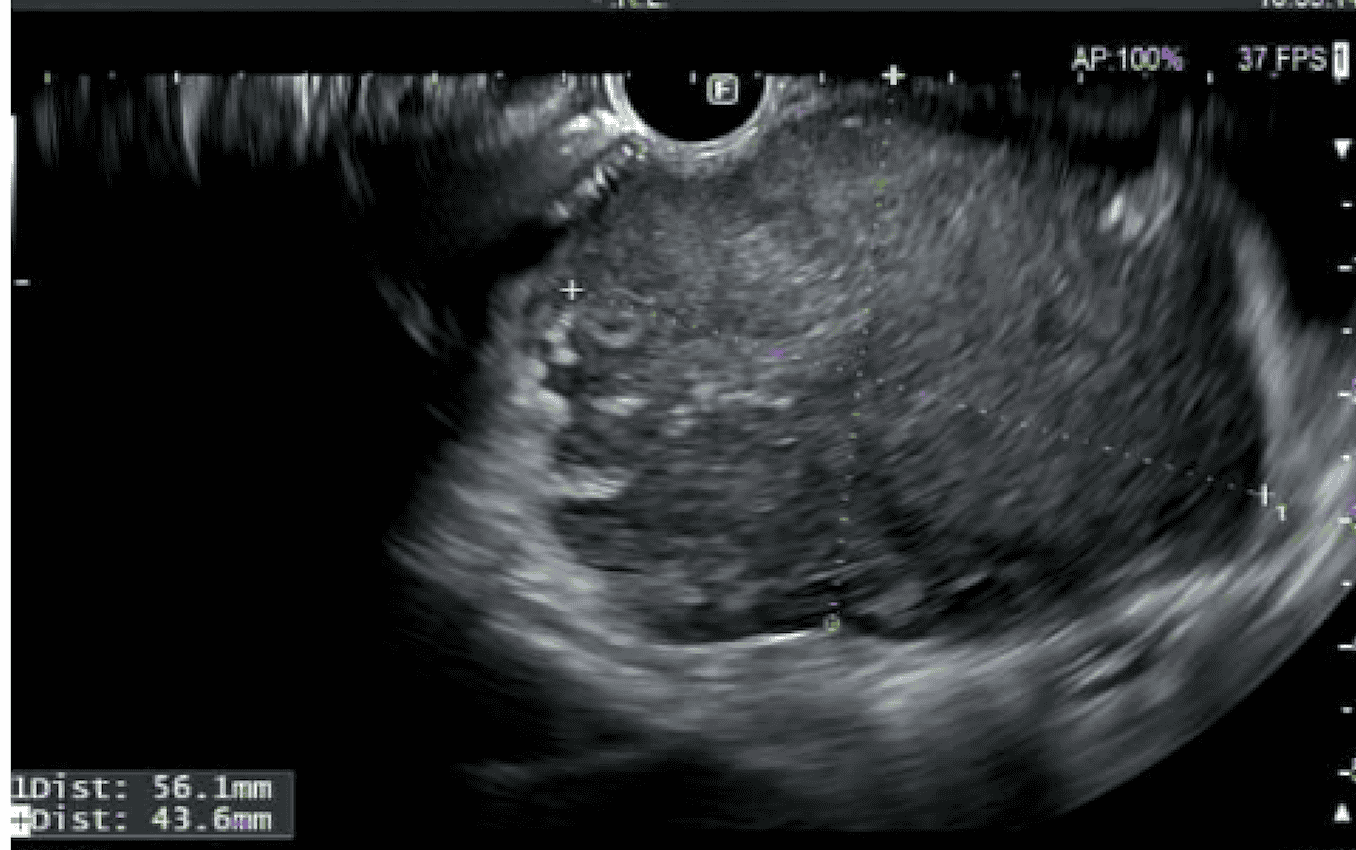Tuesday Poster Session
Category: Interventional Endoscopy
P5729 - Endoscopic Ultrasound-Guided Fine Needle Biopsy for Diagnosis of SMARCA4-Deficient Undifferentiated Thoracic Tumor: A Case Report
Tuesday, October 28, 2025
10:30 AM - 4:00 PM PDT
Location: Exhibit Hall

Khalid Ahmed, MD (he/him/his)
University of Minnesota
Minneapolis, MN
Presenting Author(s)
Khalid Ahmed, MD1, Areeba Rizvi, MD2, Constance P. Chen, BSc3, Jimmie Stewart, MD2, Ahmed Dirweesh, MD2, James Mallery, MD1
1University of Minnesota, Minneapolis, MN; 2University of Minnesota Medical Center, Minneapolis, MN; 3University of Minnesota Medical School, Minneapolis, MN
Introduction: SMARCA4-deficient undifferentiated thoracic tumors (SMARCA4-UTs) are a newly recognized, highly aggressive subset of thoracic malignancies characterized by loss of SMARCA4 expression. They typically affect middle-aged male smokers and present as large, centrally located thoracic or mediastinal masses with high metastatic potential. The clinical course is often fulminant, with limited therapeutic options and poor prognosis. Diagnosis requires both histologic and molecular confirmation, typically through immunohistochemistry for SMARCA4 (BRG1) loss. We report a rare case of SMARCA4-UT diagnosed via endoscopic ultrasound-guided fine-needle biopsy (EUS-FNB).
Case Description/
Methods: A 67-year-old male with traumatic brain injury, schizoaffective disorder, COPD, and tobacco use presented with dyspnea and pneumonia. Imaging revealed a left lower lobe mass with mediastinal lymphadenopathy. Follow-up CT showed a large mediastinal mass (10.1 x 6.6 x 9.1 cm) and new hepatic lesions concerning for metastatic disease. EUS-FNB of the mediastinal and liver lesions was performed. Cytopathologic evaluation revealed a high-grade neoplasm with loss of SMARCA4 expression, confirming SMARCA4-UT. Oncology determined that due to the aggressive disease and patient’s poor functional status, he was not a candidate for systemic therapy or surgery. He was transitioned to hospice care and passed away shortly thereafter.
Discussion: This is the first known case of SMARCA4-UT diagnosed via EUS-FNB, demonstrating the potential of this technique in the evaluation of rare thoracic malignancies. While tissue sampling is often achieved through surgical biopsy or endobronchial ultrasound (EBUS), the role of EUS-FNB in diagnosing this rare malignancy remains underexplored. In cases where the mass is adjacent to the esophagus or inaccessible via the tracheobronchial tree, EBUS may have limited diagnostic utility. In this case, EUS-FNB provided sufficient core tissue for both histologic and molecular analysis, enabling a timely and accurate diagnosis. Broader recognition of EUS-FNB’s role may improve diagnostic workflows and facilitate earlier identification of aggressive tumors like SMARCA4-UT. This case also reinforces the expanding role of gastrointestinal endoscopists in the multidisciplinary management of thoracic malignancies.

Figure: Figure 1. CT of mediastinal mass

Figure: Figure 2. EUS of mediastinal mass
Disclosures:
Khalid Ahmed indicated no relevant financial relationships.
Areeba Rizvi indicated no relevant financial relationships.
Constance Chen indicated no relevant financial relationships.
Jimmie Stewart indicated no relevant financial relationships.
Ahmed Dirweesh indicated no relevant financial relationships.
James Mallery indicated no relevant financial relationships.
Khalid Ahmed, MD1, Areeba Rizvi, MD2, Constance P. Chen, BSc3, Jimmie Stewart, MD2, Ahmed Dirweesh, MD2, James Mallery, MD1. P5729 - Endoscopic Ultrasound-Guided Fine Needle Biopsy for Diagnosis of SMARCA4-Deficient Undifferentiated Thoracic Tumor: A Case Report, ACG 2025 Annual Scientific Meeting Abstracts. Phoenix, AZ: American College of Gastroenterology.
1University of Minnesota, Minneapolis, MN; 2University of Minnesota Medical Center, Minneapolis, MN; 3University of Minnesota Medical School, Minneapolis, MN
Introduction: SMARCA4-deficient undifferentiated thoracic tumors (SMARCA4-UTs) are a newly recognized, highly aggressive subset of thoracic malignancies characterized by loss of SMARCA4 expression. They typically affect middle-aged male smokers and present as large, centrally located thoracic or mediastinal masses with high metastatic potential. The clinical course is often fulminant, with limited therapeutic options and poor prognosis. Diagnosis requires both histologic and molecular confirmation, typically through immunohistochemistry for SMARCA4 (BRG1) loss. We report a rare case of SMARCA4-UT diagnosed via endoscopic ultrasound-guided fine-needle biopsy (EUS-FNB).
Case Description/
Methods: A 67-year-old male with traumatic brain injury, schizoaffective disorder, COPD, and tobacco use presented with dyspnea and pneumonia. Imaging revealed a left lower lobe mass with mediastinal lymphadenopathy. Follow-up CT showed a large mediastinal mass (10.1 x 6.6 x 9.1 cm) and new hepatic lesions concerning for metastatic disease. EUS-FNB of the mediastinal and liver lesions was performed. Cytopathologic evaluation revealed a high-grade neoplasm with loss of SMARCA4 expression, confirming SMARCA4-UT. Oncology determined that due to the aggressive disease and patient’s poor functional status, he was not a candidate for systemic therapy or surgery. He was transitioned to hospice care and passed away shortly thereafter.
Discussion: This is the first known case of SMARCA4-UT diagnosed via EUS-FNB, demonstrating the potential of this technique in the evaluation of rare thoracic malignancies. While tissue sampling is often achieved through surgical biopsy or endobronchial ultrasound (EBUS), the role of EUS-FNB in diagnosing this rare malignancy remains underexplored. In cases where the mass is adjacent to the esophagus or inaccessible via the tracheobronchial tree, EBUS may have limited diagnostic utility. In this case, EUS-FNB provided sufficient core tissue for both histologic and molecular analysis, enabling a timely and accurate diagnosis. Broader recognition of EUS-FNB’s role may improve diagnostic workflows and facilitate earlier identification of aggressive tumors like SMARCA4-UT. This case also reinforces the expanding role of gastrointestinal endoscopists in the multidisciplinary management of thoracic malignancies.

Figure: Figure 1. CT of mediastinal mass

Figure: Figure 2. EUS of mediastinal mass
Disclosures:
Khalid Ahmed indicated no relevant financial relationships.
Areeba Rizvi indicated no relevant financial relationships.
Constance Chen indicated no relevant financial relationships.
Jimmie Stewart indicated no relevant financial relationships.
Ahmed Dirweesh indicated no relevant financial relationships.
James Mallery indicated no relevant financial relationships.
Khalid Ahmed, MD1, Areeba Rizvi, MD2, Constance P. Chen, BSc3, Jimmie Stewart, MD2, Ahmed Dirweesh, MD2, James Mallery, MD1. P5729 - Endoscopic Ultrasound-Guided Fine Needle Biopsy for Diagnosis of SMARCA4-Deficient Undifferentiated Thoracic Tumor: A Case Report, ACG 2025 Annual Scientific Meeting Abstracts. Phoenix, AZ: American College of Gastroenterology.
